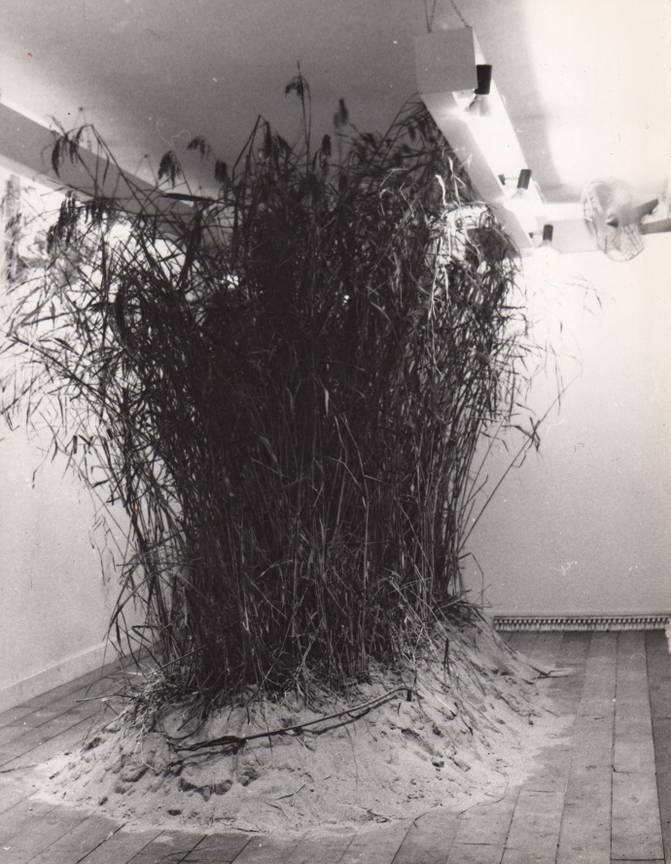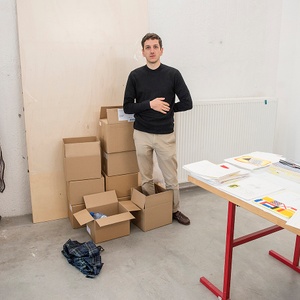For Gladstone Gallery’s summer show, guest curator Kasper Bosmans has created poetry with the hum coming from his own “stumuch” and those of six other kindred spirits. “We all share a very particular kind of chloroplast that can only bear one type of sunlight.”

Marinus Boezem’s Rietveld bewogen door ventilatoren from 1968, which will be recreated for The Hum Comes from the Stumuch. A fan makes the reeds bend in the breeze, illustrating the form of the wind
Artist Kasper Bosmans is making a little pavilion at Gladstone Gallery
Kasper Bosmans is curating. That was all it took to excite our curiosity. The artist who avidly picks at all the things that come into his head, and like a spider in the web of the world, spins sticky threads between them all in an intensely attractive visual language, was invited to bring together a group of artists to celebrate the summer at Gladstone Gallery. “A little party,” is how he himself describes it, and also: “Very egotistical. I’m making a little pavilion for myself. [Laughs] I just hope other people enjoy it too.”
Those “other people” can be very hopeful. Kasper Bosmans is exceptionally well-placed to forge unexpected connections. The still only 27-year-old, Lommel-born artist who moved to Brussels for a residency at Wiels, hits a nerve from Tallinn to Los Angeles and from Cologne to Hong Kong, by combining his Wikipedia-esque factoids, knowledge of folklore, and juicy anecdotes in a multiplicity of forms – including painted legends that depict their associative readings.
He is likewise forging connections as the guest curator of The Hum Comes from the Stumuch. “The exhibition was composed relatively intuitively, but I do increasingly see a leitmotif that runs through the whole thing. I bring several practices together that have influenced me over the past few years, to explore what the underlying connections are. It is a fun way to involve everyone in one big conversation.”
Any way the wind blows
Someone like the 84-year-old Marinus Boezem, for example, who was a pioneer of Dutch conceptual art and whose Rietveld bewogen door ventilatoren will be part of The Hum Comes from the Stumuch. “The work was created in 1968, and has never been presented since. It consists of a mountain of sand with reeds sticking out. A fan makes them bend in the breeze. It is an illustration of the form of the wind. A kind of invisible sculpture in which the reeds are the language that represents air. We are also showing a number of the weather charts that he made in the 1990s in collaboration with the Royal Dutch Meteorological Institute and on which he maps high and low pressure areas from different periods on top of one another. This creates an impossible meteorological summary. It’s a very funny way of understanding the world; both very poetic and objective at the same time.”
I enjoy being n amateur, a smallholder. That small scale can be very enriching

The Congolese autodidact Jean Katambayi Mukendi draws from his own life as the foundation of his work. “Both his parents worked for the Gécamines. After the ore mines were nationalized and the mining activities were reduced, Jean wanted to keep the knowledge about all this machinery alive, since an entire society had been structured around it. He thought it was very important to learn the techniques in an attempt to be self-sufficient and thus to evolve to a sustainable and peaceful society, by carving out an independent position for himself. In his work, this is expressed through proposals for the future, machines made of batteries, cardboard, perishable, and inferior materials. Like his Marsphairlines, for example, a kind of aeroplane fin in MDF, on which he has written a mathematical equation resulting in the date 22 March 2016. On that date, the day of the attacks in Brussels, he missed the opening of his exhibition in Antwerp. Marsphairlines actually talks about how idiotic it is to send probes to Mars while so many people are stuck, immobile in the developing world. These different speeds cause conflict. Just like in the work of Marinus Boezem, Jean Katambayi Mukendi’s practice is marked by an objective attitude. He considers his works to be educational objects, infrastructure that brings everything together: philosophy, electricity, mathematics, politics… They are peace machines, methods of thinking up a sustainable society.”
“In the moment that you make an object,” Kasper Bosmans continues, “you also get something off your chest. That distance gives you more insight. We need the Marsphairlines and Marinus’s meteorological charts to understand things better and to feel their form. I also think their interdisciplinary perspectives are much more important than innovativeness. Art and innovation are closely linked nowadays. Google pumps an enormous amount of money into it. And that is very important, but it is not my genre. A nineteenth-century associative approach will already get us very far. I enjoy being an amateur, a smallholder. That small scale can be very enriching.”
the secret life of plants
The Hum Comes from the Stumuch is also showing work by the Dutch, Brussels-based artist Sara Sejin Chang (Sara van der Heide), who uses colour codes to discuss the political dismantling of Bauhaus and then associates that with feminism, migration, and modernism. And work by Trevor Yeung, a “mainland Chinese artist” who lives in Hong Kong and manipulates the growth of plants so that he can turn them into allegories of his personal life and society at large. And by Marthe Ramm Fortun, “a very intuitive Norwegian performance artist who has a very refreshing, open attitude and who uses lined, Norwegian granite to make geological writing paper that she uses for a performance in buses. Finally, Jack Smith is an American artist who influenced the New York pop art scene with exuberant videos, and whose archive, which is managed by Barbara Gladstone in New York, contains a lot of paraphernalia and props, in addition to his schizophrenic and critical work. It also contains many memos that influenced his films and titles, but also very simple notes that were scribbled with great willpower.
They are not only very beautiful, but also very important as representatives of his attitude and imagination. We used them for the exhibition and that is also where we got our title.”
“The Hum Comes from the Stumuch is all about how everyone tries to grasp the world,” Kasper Bosmans says. “From all sides. Sometimes very greedily but sometimes also very abstemiously, purely, and calculatedly… About how all six of these artists try to establish a very specific view of a very specific subject and thus create a distance, a broadened perspective, and an expanded horizon. They are all storytellers who create from the gut, a kind of primordial need, which is perhaps more about communicating than it is about the deepest stirrings of the soul. It is about giving yourself autonomy and developing your own system to relate to your subjects and the world.” Not merely from the hum coming from the “stumuch”, but in a well-wrought, mature way. “Each of the artists needs a specific nutrient, a very particular kind of chloroplast that can only bear one type of sunlight. [Laughs] That is the common denominator.”
> The Hum Comes from the Stumuch. 22/6 > 13/7, Gladstone Gallery
Read more about: Expo
Fijn dat je wil reageren. Wie reageert, gaat akkoord met onze huisregels. Hoe reageren via Disqus? Een woordje uitleg.